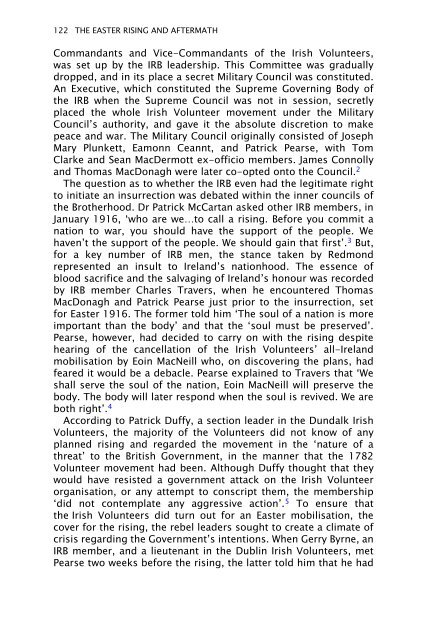Dividing Ireland: World War I and Partition
Dividing Ireland: World War I and Partition
Dividing Ireland: World War I and Partition
Create successful ePaper yourself
Turn your PDF publications into a flip-book with our unique Google optimized e-Paper software.
122 THE EASTER RISING AND AFTERMATH<br />
Comm<strong>and</strong>ants <strong>and</strong> Vice-Comm<strong>and</strong>ants of the Irish Volunteers,<br />
was set up by the IRB leadership. This Committee was gradually<br />
dropped, <strong>and</strong> in its place a secret Military Council was constituted.<br />
An Executive, which constituted the Supreme Governing Body of<br />
the IRB when the Supreme Council was not in session, secretly<br />
placed the whole Irish Volunteer movement under the Military<br />
Council’s authority, <strong>and</strong> gave it the absolute discretion to make<br />
peace <strong>and</strong> war. The Military Council originally consisted of Joseph<br />
Mary Plunkett, Eamonn Ceannt, <strong>and</strong> Patrick Pearse, with Tom<br />
Clarke <strong>and</strong> Sean MacDermott ex-officio members. James Connolly<br />
<strong>and</strong> Thomas MacDonagh were later co-opted onto the Council. 2<br />
The question as to whether the IRB even had the legitimate right<br />
to initiate an insurrection was debated within the inner councils of<br />
the Brotherhood. Dr Patrick McCartan asked other IRB members, in<br />
January 1916, ‘who are we…to call a rising. Before you commit a<br />
nation to war, you should have the support of the people. We<br />
haven’t the support of the people. We should gain that first’. 3 But,<br />
for a key number of IRB men, the stance taken by Redmond<br />
represented an insult to <strong>Irel<strong>and</strong></strong>’s nationhood. The essence of<br />
blood sacrifice <strong>and</strong> the salvaging of <strong>Irel<strong>and</strong></strong>’s honour was recorded<br />
by IRB member Charles Travers, when he encountered Thomas<br />
MacDonagh <strong>and</strong> Patrick Pearse just prior to the insurrection, set<br />
for Easter 1916. The former told him ‘The soul of a nation is more<br />
important than the body’ <strong>and</strong> that the ‘soul must be preserved’.<br />
Pearse, however, had decided to carry on with the rising despite<br />
hearing of the cancellation of the Irish Volunteers’ all-<strong>Irel<strong>and</strong></strong><br />
mobilisation by Eoin MacNeill who, on discovering the plans, had<br />
feared it would be a debacle. Pearse explained to Travers that ‘We<br />
shall serve the soul of the nation, Eoin MacNeill will preserve the<br />
body. The body will later respond when the soul is revived. We are<br />
both right’. 4<br />
According to Patrick Duffy, a section leader in the Dundalk Irish<br />
Volunteers, the majority of the Volunteers did not know of any<br />
planned rising <strong>and</strong> regarded the movement in the ‘nature of a<br />
threat’ to the British Government, in the manner that the 1782<br />
Volunteer movement had been. Although Duffy thought that they<br />
would have resisted a government attack on the Irish Volunteer<br />
organisation, or any attempt to conscript them, the membership<br />
‘did not contemplate any aggressive action’. 5 To ensure that<br />
the Irish Volunteers did turn out for an Easter mobilisation, the<br />
cover for the rising, the rebel leaders sought to create a climate of<br />
crisis regarding the Government’s intentions. When Gerry Byrne, an<br />
IRB member, <strong>and</strong> a lieutenant in the Dublin Irish Volunteers, met<br />
Pearse two weeks before the rising, the latter told him that he had








